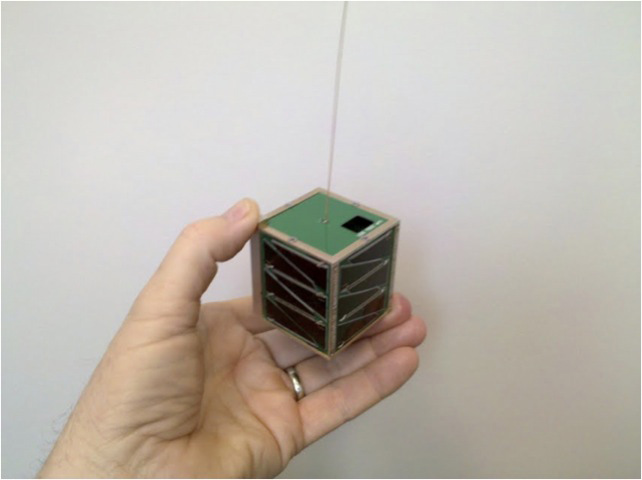Tiny Satellites Can Do Big Science

Whenit comes to laptop computers and cell phones, bigger isn?t better. The samelogic applies to satellites: the bulkier the satellite, the more time it takesto design and build, and the more expensive it is to put into orbit.
Researchersare now taking advantage of the electronics technologies that have madepersonal gizmos compact and affordable to make satellites that weigh and cost afraction of their predecessors. These pocket- and backpack-sized satellites arechanging the way astrobiologyresearch is done.
Conventionalsatellites used for communications, navigation or research can be as large as aschool bus and weigh between 100 and 500 kilograms. Universities, companies andNASA are now building small satellites that weigh less than one kilogram(picosatellites) or up to 10 kilograms (nanosatellites).
Thesesmallsatellites can be considered miniature versions of full-size counterparts.They contain the same components?battery, orbital control and positioningsystems, radio communication systems, and analytical instruments?excepteverything is smaller, less expensive and sometimes less complicated.
?That?sthe beauty of this technology,? says Orlando Santos, an astrobiologist at NASAAmes Research Center. ?We can make these things small and still get meaningfulscience out of them.?
TheRise of the Cube
Twodecades ago, Bob Twiggs and his students at Stanford University developed thefirst picosatellite the size of a Klondike ice cream bar. The AerospaceCorporation launched these picosatellites as part of a mission to demonstratethe feasibility of building little satellites that communicate with each other.
Breaking space news, the latest updates on rocket launches, skywatching events and more!
Twiggsthen worked on CubeSat, a 10-centimeter cube. ?I got a 4-inch beanie baby boxand tacked on some solar cells to see how many would fit on the surface,?Twiggs says. ?I had enough voltage for what I needed so I decided that would bethe size.?
JordiPuig-Suari at California Polytechnic State University built a deploymentmechanism called the poly picosatellite orbital deployer, or P-POD, that couldpack up to three CubeSats.One of these is typically the satellite bus, the brains of the satellitecontaining positioning and radio equipment, while the other cubes carry thescientific experiments. In 2004, the researchers sent the first three-cubenanosatellite into orbit.
Sixyears later, CubeSats have become the world-wide standard for small satellites.They are being used for everything from environmental sensing and fundamentalbiology research to testing new spaceflight systems.
Over60 universities and high schools are part of the CubeSat Project based at CalPoly. The National Science Foundation and the U.S. Air Force have programs thatfunds CubeSats for atmospheric and spaceweather research. Aerospace companies such as Lockheed Martin and Boeinghave also built and flown CubeSats.
Kentucky-basedNanoRacks LLC provides a platform to take CubeSat experiments as cargo aboardthe Space Shuttles to the International Space Station for periods of 30 or 60days, after which they bring the cubes back.
Thegoal of NASA?s new CubeSatLaunch Initiative isto radically open up the flight opportunities for nanosatellites. ThisInitiative shouldalso make it easier for universities to compete for launch access on NASAlaunch vehicles.
Thereare probably between 35 and 40 small satellites orbiting the Earth right now,of which about a quarter might still be working, says Twiggs, now a professorat Morehead State University?s Space Science Center in Kentucky.
CuttingCosts
Thebiggest advantage of nano- and pico-satellites is that they are a bargain. Mostof the cost saving comes at the launch stage. Unlike conventional satellites,they don?t need a dedicated launch vehicle where they are the primary payload.?They?re so small they can hitch a ride on somebody else?s rocket,? Santos says.
NASA?snanosatellite missions cost $2 million apiece as opposed to the tens ofmillions needed for a conventional satellite.
Theiraffordability also comes from being built with off-the-shelf electronic circuitchips such as microprocessors and radio frequency transmitters and receivers.These are the same components that are inside smart phones, hand-held GlobalPositioning System units, and digital cameras.
Infact, the miniaturization of electronics has been the driving force behindsmall satellite technology, making it affordable, says Twiggs. ?Electronicstoday are much more power-efficient than electronics of the past; that helpsus,? he says. ?Ten or fifteen years ago we couldn?t have found the componentsfor the price that we could?ve afforded.?
Smallsatellites shouldn?t add to the problem of space debris since they arerelatively easy to deorbit. NASA?s upcoming nanosatellite mission,Organism/Organic Exposure to Orbital Stresses (O/OREOS), will have a sailpacked into it that will be deployed at the end of the mission.
?Itincreases the satellite?s surface area and speeds up its fall to Earth,? Santossays. ?It?s so small it?ll burn up soon as it enters the atmosphere.? [O/OREOSmission up close.]
Thelow cost and relatively quick turnaround time of a few months makesnanosatellites invaluable from an education perspective. Students and youngengineers get to participate in a project from the initial paper design tobuilding and testing to the eventual launch. This gives next-generationscientists hands-on experience in development, management and mission training.
Astrobiologyin Miniature
ForNASA, low-cost nanosatellites are an ideal platform for science and technology,including fundamental biology and astrobiology research.
?Astrobiologyis ripe for the use of small satellites,? says Jason Crusan, chief technologistfor space operations at NASA headquarters in Washington, D.C. Performing alarge number of experiments is best for studying biological processes. ?If youcan increase your flight frequency then you increase the number of experimentsyou need to do but you need a lower-cost solution like nanosatellites to do this.?
Besides,unlike astronomy, experiments for astrobiology lend themselves tominiaturization. This is due to advances in microfluidics technologies and theminiaturization of optical detection instruments. For instance, thespectrometer on O/OREOS is the size of a candy bar.
Santossays that there is an intense interest in astrobiology and life sciences togain access to interplanetary conditions above low-Earth orbit. That?s whereyou can study how living organisms and life-related compounds are affected bythe cosmic radiation above the Earth?s protective atmosphere and by reducedgravity. ?That?s how we can study the big questions in astrobiology,? he says.?What happens when we go to space? Or are we carrying microorganisms that maycontaminate science experiments??
Sofar, NASA has launched two nanosatellites into low-Earth orbit between 450 and550 kilometers above the surface. GeneSat, which was launched in December 2006,studied the effects of space on bacteria, while PharmaSat, which went up in May2009, investigated the effects of antifungal agents on yeast growth in space.The O/OREOS satellite, which will be launched late this year into 650-kilometerorbit, will study the effects of a larger array of space conditions on microbesand important biological compounds.
Inthe future, nanosatellites may allow experiments to reach beyond low-Earthorbit. They could go into lunar orbit or into solar orbit halfway between theEarth and Venus, or one day even land on the moon. Envoys of CubeSats that havemore smarts and a built-in thrust mechanism might even be sent out to explorevast swaths of our solar system and beyond.
?Orbitingother planets or landing on the surface, these nano-explorers could search forcompounds that signal the existence of life, communicating their findings witheach other and with controllers on Earth.
Twiggsis now working with researchers at the University of Rome on pocket-sized5-centimeter cubes. Because these are an eighth of the volume of regularCubeSats, Twiggs hopes they will cost that much less. The team is planning tolaunch eight of these pocket cubes packed inside a launcher on a Russianballistic missile by spring of 2011.
Nano-and picosatellites will not replace their larger cousins?there are certainexperiments that cannot be miniaturized or that need more power and hence morearea for solar panels and antennae.
?Everybodydoesn?t drive a little teeny car, there are big trucks to carry things around,?Twiggs says.? Instead, small satellites should open up a new way to do researchand education, proving that good things can come in small packages.
- NASA'sMost Memorable Missions
- Outer SpaceOreos
- UKto Launch Homegrown Mini-Satellite Cube
Prachi Patel is a Pittsburg-based freelancer and former contributor to Space.com who wrote about Mars, energy, materials science, satellites, technology, nanotechnology, and computing. She holds a master's degree in electrical engineering and a master's in science journalism. Before becoming a current editor at Chemical & Engineering News, she was a successful freelance science journalist, contributing frequently to C&EN, IEEE Spectrum, MRS Bulletin, Anthropocene, Nature, and Scientific American.
